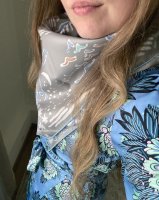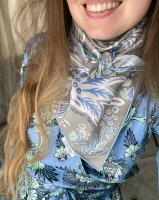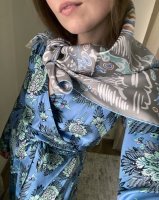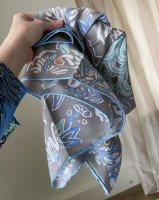So interesting, thank you.Le Premier Chant by Sophia Andreotti and Edouard Baribeaud is my first Hermès scarf of the 2022 Spring/Summer collection. Usually Hermès posts a “story behind” explanation about the meaning of the design, but so far Hemès has not provided a text.
In my Instagram account, livinglavidafifi, I often post about Hermès scarves providing background information about the designs. I will soon be posting about Le Premier Chant and have examined the carré and wrote some thoughts about the illustration. I will use part of what I wrote when I create my IG post.
I thought some may be interested in my interpretation of the design. If anyone wishes to quote or use any part of this text, all I ask is that you please credit me.
View attachment 5282574
Le Premier Chant by Sophie Andreotti and Edouard Baribeaud
Hermès wonderful carré, Le Premier Chant, (The First Song), designed by Sophia Andreotti and Edouard Baribaud for its Spring/Summer 2022 collection is not only a festival of color and beautiful patterns, but a design full of deep meaning and symbolism.
The illustration depicts a young woman in her room adorned by beautifully patterned textiles with a starry desert landscape beyond. As an inspired singer, her treasured possessions are close: her guitar, microphone, amplifier, and on a nearby table, a book entitled La Loba: the female wolf of lore; the mythical empowered female who is a wild creative force. The young singer arches her back to belt out a song filled with the force of a primordial chant. Her song rises organically as a beautiful, rhythmical tidal wave and becomes a hymn of creation, an anthem to the power of the artistic soul.
The myth and lore of the primordial chant, of a song of creation, appears in the literature and folklore of various cultures throughout the ages. Historically the Book of Genesis was sung by the ancient Hebrews; the Celts spoke of the Oran Mor, or neverending Great Melody; Australian aborigines tell of their land having been sung into being.
Perhaps one of the best known and poetic examples of the song of creation exists in J.R.R. Tolkien’s The Silmarillion. Tolkien begins his creation myth by describing how the universe is “sung into being” by spiritual creatures named the Ainur. These creatures are invited by God to sing a great song of creation, having been provided a theme upon which they are to improvise.
The fabled God states, “Of the theme that I have declared to you, I will now that ye make in harmony together a Great Music. And since I have kindled you with the Flame Imperishable, ye shall show forth your powers in adorning this theme, each with his own thoughts and devices, if he will. But I will sit and hearken, and be glad that through you great beauty has been wakened into song.” C.S. Lewis illustrates a similar tale of song and creation in his The Magician’s Nephew, where the noble Aslan sings and the world begins to take form.
But the book displayed on the young singer’s tabletop may be more indicative of her spirit and source of her inspiration. It is entitled La Loba, (The She-Wolf), alluding to the mythical, wild woman of the Pueblo people popularized by Clarissa Pinkola Estés in her Women Who Run With the Wolves.
According to Estés, the tale tells of a woman who lives in a remote cave waiting for wanderers and seekers to visit. She toils collecting bones and “to collect and preserve especially that which is in danger of being lost to the world.” Estés explains that “when she has assembled an entire skeleton, when the last bone is in place and the beautiful white sculpture of the creature is laid out before her, she sits by the fire and thinks about what song she will sing. And when she is sure, she stands over the criatura, raises her arms over it, and sings out. That is when the rib bones and leg bones of the wolf begin to flesh out and the creature becomes furred. La Loba sings some more, and more of the creature comes into being; its tail curls upward, shaggy and strong. And La Loba sings more and the wolf creature begins to breathe. And still La Loba sings so deeply that the floor of the desert shakes, and as she sings, the wolf opens its eyes, leaps up, and runs away down the canyon. Somewhere in its running, whether by the speed of its running, or by splashing its way into a river, or by way of a ray of sunlight or moonlight hitting it right in the side, the wolf is suddenly transformed into a laughing woman who runs free toward the horizon.”
So, in essence, we are witnessing that mythical, powerful, utterly creative Wolf Woman in a young modern incarnation, bringing the universe to life and displaying the power of her song. Estés poetically states, “So it is said that if you wander the desert, and it is near sundown, and you are perhaps a little bit lost, and certainly tired, that you are lucky, for La Loba may take a liking to you and show you something - something of the Soul.”
In this carré, we meet that youthful woman who runs with wolves and weaves her magical and powerful tale. The design is full of beautiful, decorative patterns evocative of Indian miniatures and the dense jungles of Rousseau in the artists’ unique style. A design not only full of harmonious patterns, symmetries, colors and textures, but also of dynamic juxtapositions, it is a fascinating pean to the creative spirit and the female force.
-Josie Sullivan
You are using an out of date browser. It may not display this or other websites correctly.
You should upgrade or use an alternative browser.
You should upgrade or use an alternative browser.
Scarves Spring/summer 2022 scarves
- Thread starter hermeshound
- Start date
TPF may earn a commission from merchant affiliate
links, including eBay, Amazon, and others
More options
Who Replied?Le Premier Chant by Sophia Andreotti and Edouard Baribeaud is my first Hermès scarf of the 2022 Spring/Summer collection. Usually Hermès posts a “story behind” explanation about the meaning of the design, but so far Hemès has not provided a text.
In my Instagram account, livinglavidafifi, I often post about Hermès scarves providing background information about the designs. I will soon be posting about Le Premier Chant and have examined the carré and wrote some thoughts about the illustration. I will use part of what I wrote when I create my IG post.
I thought some may be interested in my interpretation of the design. If anyone wishes to quote or use any part of this text, all I ask is that you please credit me.
View attachment 5282574
Le Premier Chant by Sophie Andreotti and Edouard Baribeaud
Hermès wonderful carré, Le Premier Chant, (The First Song), designed by Sophia Andreotti and Edouard Baribaud for its Spring/Summer 2022 collection is not only a festival of color and beautiful patterns, but a design full of deep meaning and symbolism.
The illustration depicts a young woman in her room adorned by beautifully patterned textiles with a starry desert landscape beyond. As an inspired singer, her treasured possessions are close: her guitar, microphone, amplifier, and on a nearby table, a book entitled La Loba: the female wolf of lore; the mythical empowered female who is a wild creative force. The young singer arches her back to belt out a song filled with the force of a primordial chant. Her song rises organically as a beautiful, rhythmical tidal wave and becomes a hymn of creation, an anthem to the power of the artistic soul.
The myth and lore of the primordial chant, of a song of creation, appears in the literature and folklore of various cultures throughout the ages. Historically the Book of Genesis was sung by the ancient Hebrews; the Celts spoke of the Oran Mor, or neverending Great Melody; Australian aborigines tell of their land having been sung into being.
Perhaps one of the best known and poetic examples of the song of creation exists in J.R.R. Tolkien’s The Silmarillion. Tolkien begins his creation myth by describing how the universe is “sung into being” by spiritual creatures named the Ainur. These creatures are invited by God to sing a great song of creation, having been provided a theme upon which they are to improvise.
The fabled God states, “Of the theme that I have declared to you, I will now that ye make in harmony together a Great Music. And since I have kindled you with the Flame Imperishable, ye shall show forth your powers in adorning this theme, each with his own thoughts and devices, if he will. But I will sit and hearken, and be glad that through you great beauty has been wakened into song.” C.S. Lewis illustrates a similar tale of song and creation in his The Magician’s Nephew, where the noble Aslan sings and the world begins to take form.
But the book displayed on the young singer’s tabletop may be more indicative of her spirit and the source of her inspiration. It is entitled La Loba, (The She-Wolf), alluding to the mythical, wild woman of the Pueblo people popularized by Clarissa Pinkola Estés in her Women Who Run With the Wolves.
According to Estés, the tale tells of a woman who lives in a remote cave waiting for wanderers and seekers to visit. She toils collecting bones and “to collect and preserve especially that which is in danger of being lost to the world.” Estés explains that “when she has assembled an entire skeleton, when the last bone is in place and the beautiful white sculpture of the creature is laid out before her, she sits by the fire and thinks about what song she will sing. And when she is sure, she stands over the criatura, raises her arms over it, and sings out. That is when the rib bones and leg bones of the wolf begin to flesh out and the creature becomes furred. La Loba sings some more, and more of the creature comes into being; its tail curls upward, shaggy and strong. And La Loba sings more and the wolf creature begins to breathe. And still La Loba sings so deeply that the floor of the desert shakes, and as she sings, the wolf opens its eyes, leaps up, and runs away down the canyon. Somewhere in its running, whether by the speed of its running, or by splashing its way into a river, or by way of a ray of sunlight or moonlight hitting it right in the side, the wolf is suddenly transformed into a laughing woman who runs free toward the horizon.”
So, in essence, we are witnessing that mythical, powerful, utterly creative Wolf Woman in a young modern incarnation, bringing the universe to life and displaying the power of her song. Estés poetically states, “So it is said that if you wander the desert, and it is near sundown, and you are perhaps a little bit lost, and certainly tired, that you are lucky, for La Loba may take a liking to you and show you something - something of the Soul.”
In this carré, we meet that youthful woman who runs with wolves and weaves her magical and powerful tale. The design is full of beautiful, decorative patterns evocative of Indian miniatures and the dense jungles of Rousseau in the artists’ unique style. A design not only full of harmonious patterns, symmetries, colors and textures, but also of dynamic juxtapositions, it is a fascinating pean to the creative spirit and the female force.
-Josie Sullivan
Le Premier Chant by Sophia Andreotti and Edouard Baribeaud is my first Hermès scarf of the 2022 Spring/Summer collection. Usually Hermès posts a “story behind” explanation about the meaning of the design, but so far Hemès has not provided a text.
In my Instagram account, livinglavidafifi, I often post about Hermès scarves providing background information about the designs. I will soon be posting about Le Premier Chant and have examined the carré and wrote some thoughts about the illustration. I will use part of what I wrote when I create my IG post.
I thought some may be interested in my interpretation of the design. If anyone wishes to quote or use any part of this text, all I ask is that you please credit me.
View attachment 5282574
Le Premier Chant by Sophie Andreotti and Edouard Baribeaud
Hermès wonderful carré, Le Premier Chant, (The First Song), designed by Sophia Andreotti and Edouard Baribaud for its Spring/Summer 2022 collection is not only a festival of color and beautiful patterns, but a design full of deep meaning and symbolism.
The illustration depicts a young woman in her room adorned by beautifully patterned textiles with a starry desert landscape beyond. As an inspired singer, her treasured possessions are close: her guitar, microphone, amplifier, and on a nearby table, a book entitled La Loba: the female wolf of lore; the mythical empowered female who is a wild creative force. The young singer arches her back to belt out a song filled with the force of a primordial chant. Her song rises organically as a beautiful, rhythmical tidal wave and becomes a hymn of creation, an anthem to the power of the artistic soul.
The myth and lore of the primordial chant, of a song of creation, appears in the literature and folklore of various cultures throughout the ages. Historically the Book of Genesis was sung by the ancient Hebrews; the Celts spoke of the Oran Mor, or neverending Great Melody; Australian aborigines tell of their land having been sung into being.
Perhaps one of the best known and poetic examples of the song of creation exists in J.R.R. Tolkien’s The Silmarillion. Tolkien begins his creation myth by describing how the universe is “sung into being” by spiritual creatures named the Ainur. These creatures are invited by God to sing a great song of creation, having been provided a theme upon which they are to improvise.
The fabled God states, “Of the theme that I have declared to you, I will now that ye make in harmony together a Great Music. And since I have kindled you with the Flame Imperishable, ye shall show forth your powers in adorning this theme, each with his own thoughts and devices, if he will. But I will sit and hearken, and be glad that through you great beauty has been wakened into song.” C.S. Lewis illustrates a similar tale of song and creation in his The Magician’s Nephew, where the noble Aslan sings and the world begins to take form.
But the book displayed on the young singer’s tabletop may be more indicative of her spirit and the source of her inspiration. It is entitled La Loba, (The She-Wolf), alluding to the mythical, wild woman of the Pueblo people popularized by Clarissa Pinkola Estés in her Women Who Run With the Wolves.
According to Estés, the tale tells of a woman who lives in a remote cave waiting for wanderers and seekers to visit. She toils collecting bones and “to collect and preserve especially that which is in danger of being lost to the world.” Estés explains that “when she has assembled an entire skeleton, when the last bone is in place and the beautiful white sculpture of the creature is laid out before her, she sits by the fire and thinks about what song she will sing. And when she is sure, she stands over the criatura, raises her arms over it, and sings out. That is when the rib bones and leg bones of the wolf begin to flesh out and the creature becomes furred. La Loba sings some more, and more of the creature comes into being; its tail curls upward, shaggy and strong. And La Loba sings more and the wolf creature begins to breathe. And still La Loba sings so deeply that the floor of the desert shakes, and as she sings, the wolf opens its eyes, leaps up, and runs away down the canyon. Somewhere in its running, whether by the speed of its running, or by splashing its way into a river, or by way of a ray of sunlight or moonlight hitting it right in the side, the wolf is suddenly transformed into a laughing woman who runs free toward the horizon.”
So, in essence, we are witnessing that mythical, powerful, utterly creative Wolf Woman in a young modern incarnation, bringing the universe to life and displaying the power of her song. Estés poetically states, “So it is said that if you wander the desert, and it is near sundown, and you are perhaps a little bit lost, and certainly tired, that you are lucky, for La Loba may take a liking to you and show you something - something of the Soul.”
In this carré, we meet that youthful woman who runs with wolves and weaves her magical and powerful tale. The design is full of beautiful, decorative patterns evocative of Indian miniatures and the dense jungles of Rousseau in the artists’ unique style. A design not only full of harmonious patterns, symmetries, colors and textures, but also of dynamic juxtapositions, it is a fascinating pean to the creative spirit and the female force.
-Josie Sullivan
Dear Josie, this is a wonderful piece about the scarf. As you may know, I attempt to write a useful blog post about each scarf that I own, which I call “Scarf of the Moment”. In a week or so, I will try to write one for this scarf, as I have a different colourway to yours. Would you give me permission to use some of your insightful post? I will, of course, give you and TPF full attribution. You have written so well that I don’t think I could match your expertise in any way! Best wishes,




What a lovely thing to say! So glad you enjoyed my explanation… Thank you so very kindlyThank you for sharing this enthralling interpretation of the beautiful design that you wear so well, as all of your amazing scarves.
Beside being a lovely model, you are a talented writer
Fairies have been generous to you, Living.la.vida.fifi - Josie Sullivan !
My pleasure… Thank you so much!So interesting, thank you.
Thank you so much! I am so humbled by your beautiful words, especially because I so enjoy and admire your blog. Of course you may quote this post on your blog. I would be honoredDear Josie, this is a wonderful piece about the scarf. As you may know, I attempt to write a useful blog post about each scarf that I own, which I call “Scarf of the Moment”. In a week or so, I will try to write one for this scarf, as I have a different colourway to yours. Would you give me permission to use some of your insightful post? I will, of course, give you and TPF full attribution. You have written so well that I don’t think I could match your expertise in any way! Best wishes,
Seven colorways of Le Premier Chant are up on US h.com tonight, including this gorgeous CW03.Le Premier Chant by Sophia Andreotti and Edouard Baribeaud
Ref number: H003799S 03
Vieux Rose/Vert/Jaune
Here are some pictures. I presently have a hand injury so it’s hard to make good knots. Will try again later once I feel better and promise to post again
View attachment 5282154
View attachment 5282155
View attachment 5282156
View attachment 5282157
View attachment 5282158
View attachment 5282159
View attachment 5282160
View attachment 5282161
View attachment 5282162
View attachment 5282164
ooh I'd like to know too!does anyone know about kyoto marble twilly 2022ss?
I heared it's not revival, a bit diffrent from previous season.
Here is the GrenadineIs this S/S 2022?
H003891S 02 (Gold)
H003891S 03 (Grenadine)
View attachment 5282956View attachment 5282955
Lumiere scarf 90 | Hermès USA (hermes.com)

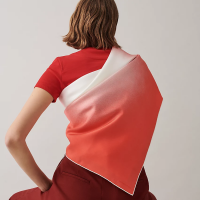
Very interesting. I guess this shows that you can wear grenadine with two different shades of red, but I’m not convinced that I want to. I’m still of the mindset that the design should show the value of the Hermès price point and this one doesn’t do it for me. I’ll be interested to see if others can prove me wrong.
Apparently the simplest design can be deceivingly hard to produce as H scarves are done via screen printing rather than inkjet printing. But I get your point - very OT this - I have similar views on Rothko paintings (while my son raves over them and buyers value them at mindboggling prices)!Very interesting. I guess this shows that you can wear grenadine with two different shades of red, but I’m not convinced that I want to. I’m still of the mindset that the design should show the value of the Hermès price point and this one doesn’t do it for me. I’ll be interested to see if others can prove me wrong.
A few colorways of the Faubourg Tropical shawl tooSeven colorways of Le Premier Chant are up on US h.com tonight, including this gorgeous CW03.
Also a few Les Leopards and a Splash Park.
Oh, it is lovely and looks striking with your dress!Here´s my first one for this season, actually wanted to resist adding 90s, but this is just too lovely..Its not spectacular, but I love its nonchalance .. Definitely a spring mood..
Isola di Primavera by Matthieu Cosse, CW 10
View attachment 5283223
View attachment 5283226
View attachment 5283227
View attachment 5283228
Here´s my first one for this season, actually wanted to resist adding 90s, but this is just too lovely..Its not spectacular, but I love its nonchalance .. Definitely a spring mood..
Isola di Primavera by Matthieu Cosse, CW 10
View attachment 5283223
View attachment 5283226
View attachment 5283227
View attachment 5283228
I love these pretty, soft colors - so wearable! And it looks fabulous on you.
It doesn't always have to be a wow if it speaks to you (wow scarves are sometimes harder for me to wear). I love this colorway, too:

This is gorgeous and going on my season wishlist. Thanks for posting.
Register on TPF! This sidebar then disappears and there are less ads!






